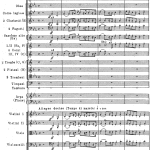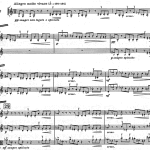Doubling at the perfect unison involves above all a fusion of tone color and an increase in the density of the sound, while volume (amplitude) is only partly affected (cf. Dynamics and Balance). The opening of Bizet’s L’Arlesienne Suite No. 1 is simply a melody doubled at the perfect unison; the result is in an intense tutti sound, a sonorous alloy of woodwinds, horns and strings.
Figure 38 · Bizet, L’Arlesienne Suite No. 1, m. 1
A similar example, composed entirely of a single unison line, is the previously mentioned movement from Britten’s Variations on a theme of Frank Bridge (Figure 28). Unison doublings can lead to such unusual situations, that the concepts of classical music theory fall short, once again suggesting the necessity of a unique music theory associated with the field of instrumentation. The concept of a four-part fugue in perfect unison may not seem immediately apparent, and will not be found in any existing work on music theory. Yet it is precisely what nineteen-year-old Benjamin Britten realized in the last movement of the same work.
Figur 39 · Britten,Variations on a theme of Frank Bridge, number. 28, m. 6
1st violins, 2nd violins, violas and cellos enter one by one with the fugue theme and continue in the customary way with a counterpoint, repeated at every new entry of the theme while a new counterpoint is added. But the music has been composed so artfully, that the theme combined with the gradually added counterpoints never creates harmony or chords. In a concert hall, the effect is striking: the listener hears a single unison line, and at the same time, paradoxically, the exposition of a classical fugue resulting solely from the sonority of the different instruments and their spatial location. It hardly needs mentioning that a piano reduction of this fugue would be pointless …
· · ·
Next · Octaves (Chapter 4. Unisono and Doubling)

